
English Version
| Welcome |
| Les Halles |
| Toulouse |
| Luxembourg |
| Nashville |
| San Diego |
| Dead And Gone |
| Bookmarks |
| Email me! |

San Diego, California (1)
IntroductionSixth largest city in the US and second in California with a population of almost 1.2 million and 2.7 for San Diego county in 1997 (California Dept. of Finance), San Diego underwent major changes in the past twelve years. The old downtown, ugly and unsafe, was torn down and became much nicer as an open air large mall, and many stores, restaurants and movie theaters where walking is a really enjoyable experience. Fourteen years after my first trip there, I could hardly recognize anything. This and an almost perfect climate make San Diego a great place to spend some time, or to live. |
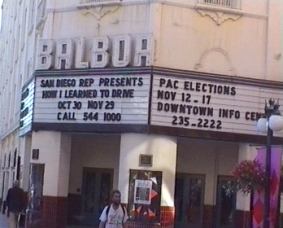 | 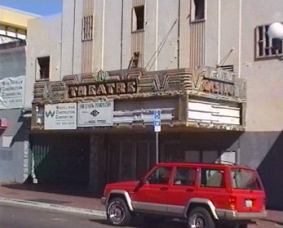 |
| The Balboa (4th and E) is used as a live theater | The Casino (643 5th) is waiting for its fate... |
| All the old movie theaters downtown, that mostly played double bill action movies, closed down, and were replaced by two new state of the art complexes, the United Artists Horton Plaza (14 screens, in the mall), and the Pacific Gaslamp All Stadium 15 (well, 15 screens, 5th and G). Both offer SRD, DTS and SDDS digital sound, and the United Artists offers THX. The Gaslamp is located at the place of the former bijou, but also uses adjacent buildings.The lobby is vast, and the auditoriums, each with stadium seating and wall-to-wall screens of course, are located on two levels, the largest ones offering seventy feet wide screens. Very few large cities in the United States have a downtown with large modern movie theaters, and it's nice to be able to eat or have a drink right after the movie, without having to drive. |
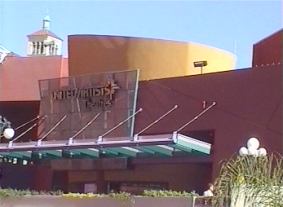 | 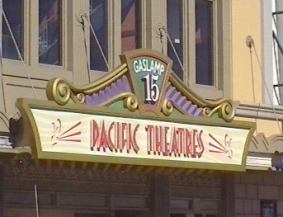 | |
| The United Artists Horton Plaza | The Pacific Gaslamp sign |
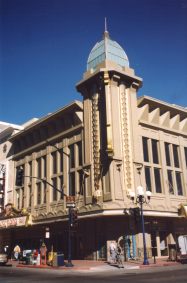 |
|
San DiegoCinema 21The Cinema 21 (1440 Hotel Circle North) was easily accessible from I-8 and was also easily seen of off I-8. The Marquee was easily seen when heading west on I-8 which is on the north side of the expressway.
The Box Office was separate from the building with one roof connecting it to the main building. There are two box office windows, but only one was used the majority of the time. During the later years, the theater used more sophisticated computer systems with monitors that could be used by the touch of the finger instead of using a normal computer keyboard. The box office also used a separete A/C to keep the inside cool. Credit Cards and ATM Cards were not used for payment. Personal Checks were used for payment, but Mann Theaters decided not to accept personal checks due to problems. So, only cash and travelers checks were accepted. The prices were as follows for this theater: $7.50 for General admission for all shows beginning at 5pm or after and $4.50 for Bargain Matinee shows. Senior Citizen, Military and Children and Adults shared the same price of $4.50 for all shows before 5pm and then, the discounts changed. Seniors, Military and Children shared the $4.50 price and adults paid the $7.50 price for all shows beginning on or after 5pm. The parking lot was adequate for ample parking, except for when a show would bring in a full house of 986 patrons, then cars would line up one side of the street heading west along the curb once the parking lot was full. That was due to the fact that there are tennis courts adjacent to the parking lot which are owned by Handlery Hotels. But, after the first few weeks or so, attendance would drop considerably to allow ample parking, depending on the show. The lobby was big enough to handle a large crowd of people. The concession stand had at least six cash registers. There were back-up popcorn warmers at each end of the stand in which patrons could see while standing in line. There were also three soda fountains to make it easy for employees to gain access during heavy business times. The ticket taker stand was located just a few feet from the main door entrance. For heavy traffic and long lines, lines were organized in such a way with separators and wrapped around the building. |
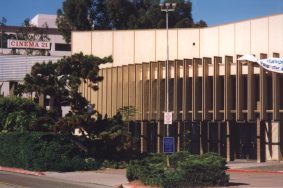 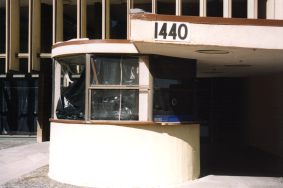 |
|
The main corridor was right to the right of the concession stand with
four main door ways to allow entry into the auditorium. Often, patrons
would get confused as to where the entrance to the auditorium was, but
with the help of the employees, they were easily guided in the right
direction. Now, for the best part of the story. The auditorium consisted of seating 940 comfortably, but could seat 986 for big sell out shows. The last ten rows of seats were reclining seats, where the front ones were not reclining seats. There was a total of 32 speakers situated through out the auditorium while the speaker behind the screen were situated accordingly. The silver screen, itself was a total of 60 feet. There was a 30-second time delay surround that could be noticed if you sat in the middle of the theater from front to back. The theater used the Dolby Digital/DTS Digital Sound processor and amps. For most pictures, you would see either the Dolby Digital or DTS Digital Sound trailers or both at the same time before the Mann Theaters Trailer, but after the film trailers. Now, the company used a huge film projector with a powerful light bulb source and a triple platter film reel system. The film projector is capable of reading the Dolby Digital and DTS Digital Sound audio tracks. For some historical information, the theater opened in July of 1963. It is bigger than its counterpart, the Valley Circle (which has been torn down). It was followed by the Center Theater in 1965, Valley Circle in December of 1966, AMC Fashion Valley 4 in June of 1970 (which is now not in existance since the inception of the mall redsign and the all new AMC Fashion Valley 18), and the Mann Hazard Center 7 in July of 1990 with each auditorium certified by Lucas Film LTD. THX. Also, what has followed before the Fashion Valley 18 was the Mission Valley 20 which is owned by AMC. So, heavy competition has prevailed over the single screen theaters within the same vicinity which lead to the demise of the Valley Circle permanently and the Cinema 21 (with its demise still in the air). The only theater that was a bit larger was the Grossmont Center Theater that held a total of 1,000 seats comfortably. A few of the big blockbuster hits at the Cinema 21 were: Ransom, Titanic (the biggest blockbuster of all time), the re-release of the Star Wars Trilogy and many others that has played there. Of course, there was the occasional flooding of the first few rows of the theater due to the rain and building of the parking lot and theater, but that did not fully close the theater. Even though the theater did use the latest in current technologies, the advances were not as good when the theater first opened in 1963. So, the theater has seen a lot of upgrades in its time period. Now, with its fate in the hands of the owner of the building, there is only hope that an independant outfit will buy the building, otherwise, it will be torn down. There is no possibily of building a multiplex in its spot due to space limitations, stiff competition at nearby malls, and the changing trends in todays current standards for multiplex and mega-multiplex theaters. If the building is torn down, the only big screens left will be: The Vouge in Chula Vista which shows second run films and the Star Theater in Oceanside which seats 900 in stadium style seating with a 50 foot screen. All of the other big screens have either been torn down or converted into stores. I hope and pray that the wonderful Cinema 21 will not be torn down. I just wished that I had the money to take out a lease agreement with the owners and continue to use the theater... January 1999 - Update: Four months following the closure of this once grand theater, a new business has taken over and has converted the inside of the Cinema 21 (at least the lobby portion) into a retail establishement called "The Sports Palace Warehouse". The building has not been torn down though. The company is using the "Mann Theaters" neon lighted sign that is still in its original place which was behind the concession stand.
The Loma TheaterThe Loma Theater (3150 Rosecrans), before it was converted to a book and music store, was one of San Diego's finest movie houses to ever have been built. The theater lured a high class crowd to its screen.To begin with, this theater was designed in the late 1930s, but the construction was delayed because of WWII. The opening date was May 5, 1945 and the admission to the opening Gala was the purchase of $100 or more in the US War Bonds. Fortunately, the theater flourished for decades and had many long running blockbuster films. Since the rise of multi and mega-plex theaters, this theater could not survive nor compete with them. So, in the year 1987, the theater closed after its last show of "Fatal Attraction". The longest running film at this theater was "How The West Was Won" which ran for a total of 1 year and 8 days. Other films being shown were: The Sound of Music, Disney's Fantasia and Roger and Hammersteins musicals that opened there. Now, in relation to seating, from what I remember, this theater must have had the seating capacity of at least 900 or more. The screen size must have been at least 70 feet in length (18 meters). Since the theaters demise, the building was converted to a bookstore now known as "Book Star" and a "Blockbuster Video" is right next door to it. There was no expense spared for the restoration of the building. The cost: $1,000,000 in US Currency.
The seats are really comfortable. They have arm rests that lift up for a cozy up. To get the full effects of the soundsystem, a person would be better off sitting in the center aisle of the auditorium. All auditoriums are handicapped equipped. The theater also offers other services such as: accepting credit cards at the box office and over the phone for advanced ticket purchases as well as cash and travelers checks, hearing aid assistance for the hearing impaired and other services at the Guest Services area.
AMC has other locations such as: AMC Weigand Plaza 8 (formerly known as AMC Weigand Plaza 6), AMC La Jolla 12, AMC Santee Village 8, AMC Fashion Valley 18. Most of their other locations will feature the SDDS Sound in a few auditoriums, but only the two new ones utilize the All Stadium Seating. |
To be continued...
San Diego is written by Chad M. Calpito
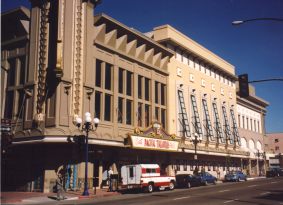
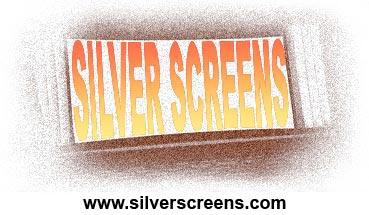 The Cinema 21 property and building is owned by Handlery Hotel.
The theater, now closed down, had one large 60-foot screen with a grand total seating
capacity of 1,000, but could comfortably seat 940-986.
The theater opened in 1963 and has shown big blockbuster hits. It was
recognized as the #1 theater in San Diego for generating the most
revenue for the re-release of the Star Wars Trilogy.
The theater utilized the Dolby Digital & DTS Digital Sound soundsystems.
Due to the opening of two multi-plex theaters such as AMC Mission Valley
20 and the AMC Fashion Valley 18, the Cinema 21 and Valley Circle closed
down. The Valley Circle was torn down and this theater utilized the same
screen size and soundsystem, but current competition killed the last two
big screens in San Diego.
The Cinema 21 property and building is owned by Handlery Hotel.
The theater, now closed down, had one large 60-foot screen with a grand total seating
capacity of 1,000, but could comfortably seat 940-986.
The theater opened in 1963 and has shown big blockbuster hits. It was
recognized as the #1 theater in San Diego for generating the most
revenue for the re-release of the Star Wars Trilogy.
The theater utilized the Dolby Digital & DTS Digital Sound soundsystems.
Due to the opening of two multi-plex theaters such as AMC Mission Valley
20 and the AMC Fashion Valley 18, the Cinema 21 and Valley Circle closed
down. The Valley Circle was torn down and this theater utilized the same
screen size and soundsystem, but current competition killed the last two
big screens in San Diego.
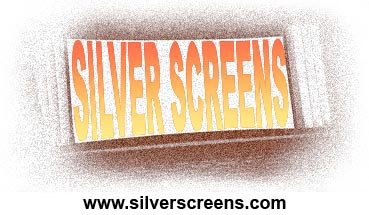 The AMC Mission Valley 20 (1640 N Camino Del Rio) opened around 1995 which boasts a grand total of 20
auditoriums with all stadium seating and wall to wall screens. The bigger
of the auditoriums feature SDDS Digital Sound while the smaller of the
auditoriums use what is called "The Hit System" and "Dolby Stereo". The
Theater uses modern architecture and design. The theater does not use
Dolby Digital, THX or DTS Digital, just SDDS (Sony Dynamic Digital Sound)
which I think is really nice and powerful providing everything that is
needed to make a movie come alive.
The AMC Mission Valley 20 (1640 N Camino Del Rio) opened around 1995 which boasts a grand total of 20
auditoriums with all stadium seating and wall to wall screens. The bigger
of the auditoriums feature SDDS Digital Sound while the smaller of the
auditoriums use what is called "The Hit System" and "Dolby Stereo". The
Theater uses modern architecture and design. The theater does not use
Dolby Digital, THX or DTS Digital, just SDDS (Sony Dynamic Digital Sound)
which I think is really nice and powerful providing everything that is
needed to make a movie come alive.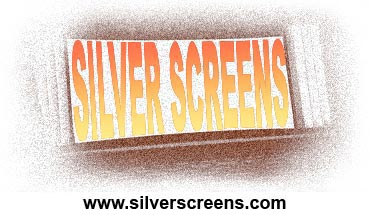 The theater has two concession stands locations. When you walk into the
lobby, you will see the main concession stand. When you head down the
corridor for theaters 1 - 13, you will notice an alternate concession
stand which will be opened during peak business hours (such as the
weekends and a big blockbuster hit, etc.). Theaters 14 - 20 are to the
right of the main lobby.
The theater has two concession stands locations. When you walk into the
lobby, you will see the main concession stand. When you head down the
corridor for theaters 1 - 13, you will notice an alternate concession
stand which will be opened during peak business hours (such as the
weekends and a big blockbuster hit, etc.). Theaters 14 - 20 are to the
right of the main lobby.